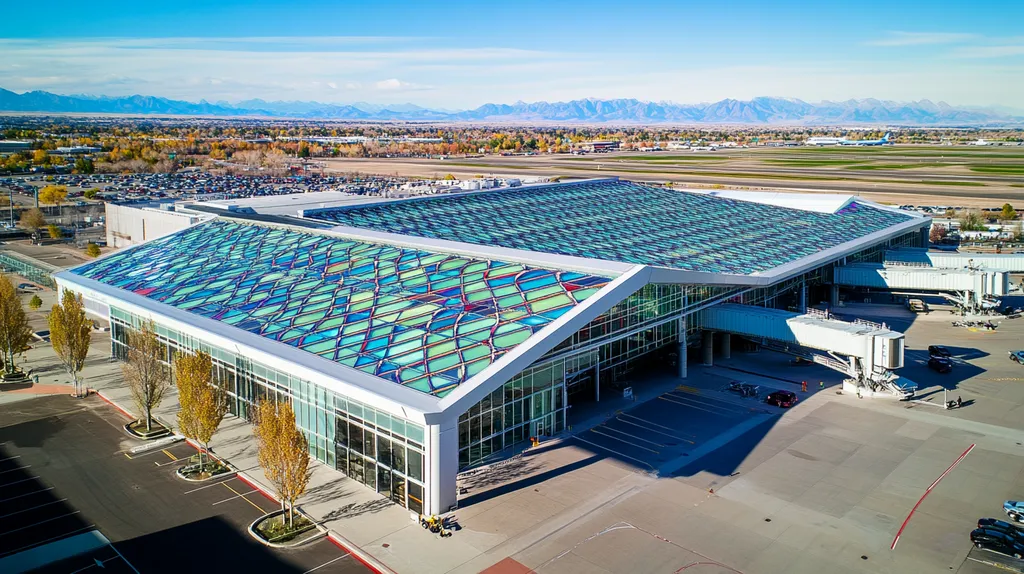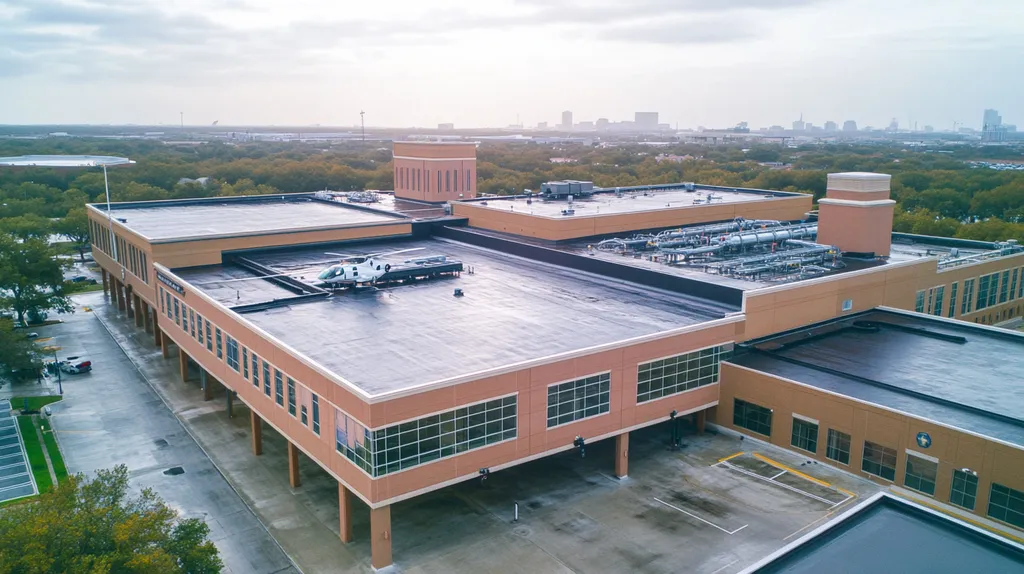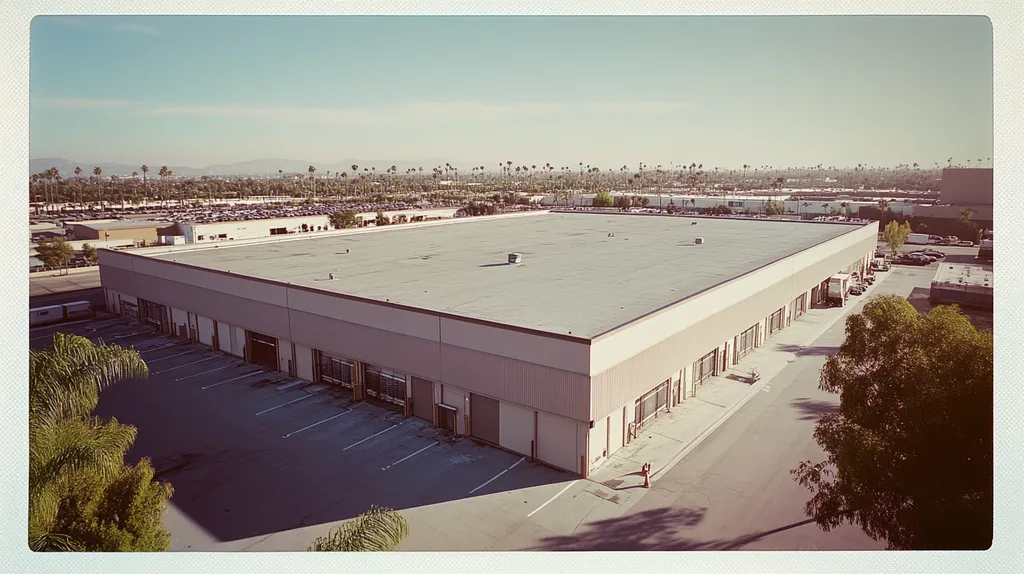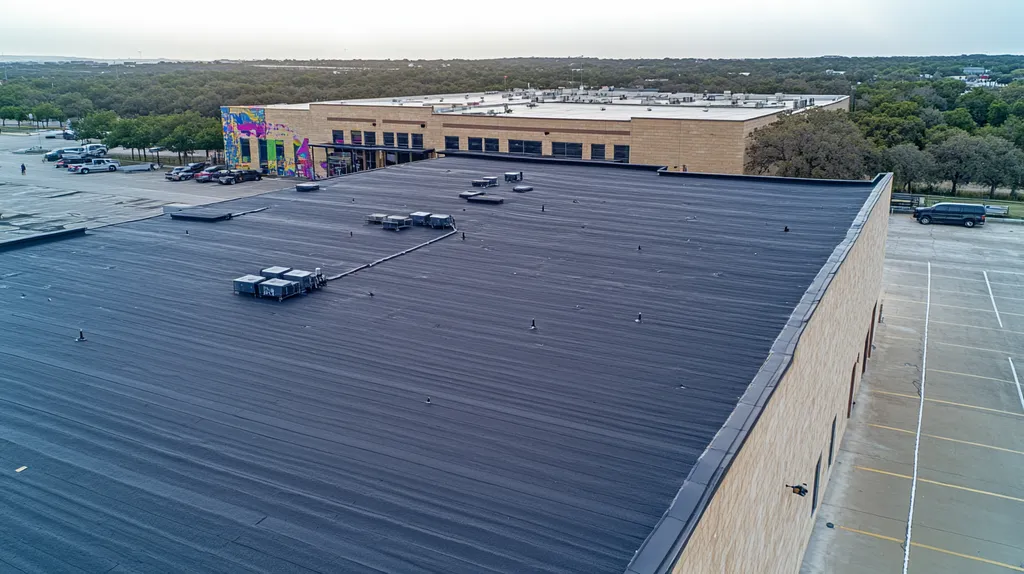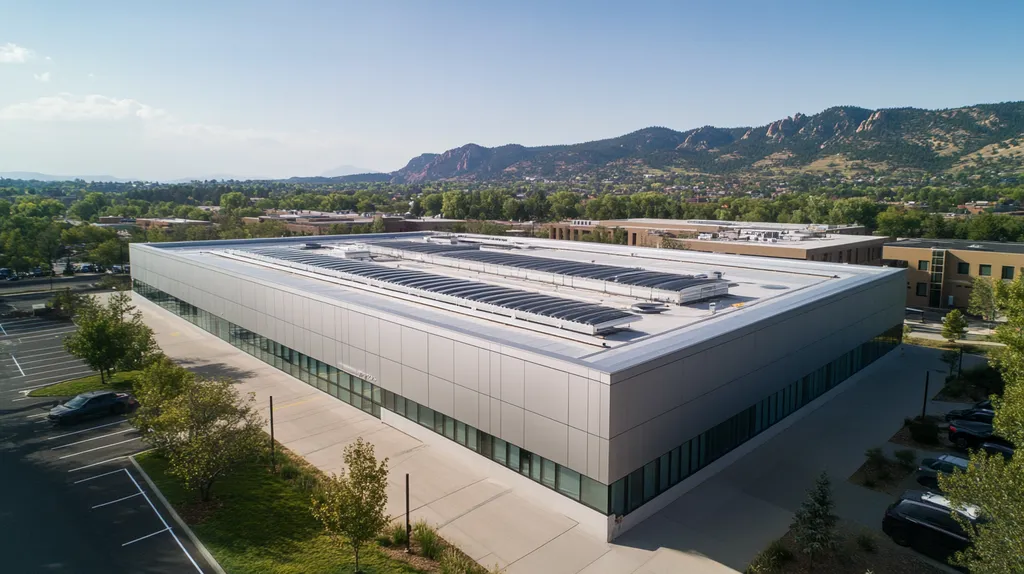In commercial roofing, timing is everything. Studies show that up to 40% of roof coating failures stem directly from poor seasonal timing during application, leading to billions in preventable damage annually.
The stakes are particularly high for industrial and commercial properties, where a single coating failure can disrupt operations and trigger costly repairs.
This comprehensive guide examines the critical factors in seasonal coating application, from material selection and weather conditions to implementation techniques that ensure maximum durability and return on investment.
SECTION 1: FUNDAMENTAL CONCEPTS
In today’s world, where maintenance costs for commercial properties can spiral out of control, effective roof management is not just important—it’s essential. The right roof coating can drastically improve a building’s durability and energy efficiency. Shockingly, up to 30% of a building’s energy loss is linked to poor roof conditions. Therefore, grasping the types of roof coatings available and their seasonal applications is vital for protecting your investment and ensuring long-term savings.
Understanding Roof Coating Types
Roof coatings can vary widely, each engineered for specific uses and benefits. Popular options include acrylic, silicone, and polyurethane coatings, and the right choice often hinges on the environment and the roof’s existing material.
Acrylic coatings are water-based and excel in protecting against UV rays and heat, making them perfect for warmer climates. On the other hand, silicone coatings are exceptionally resilient and water-resistant, ideal for areas that frequently experience extreme weather. Polyurethane coatings offer flexibility but need careful evaluation based on the roof’s surface before application.
Selecting the right coating is critical for durability and performance. Property owners should examine their roof’s current material and local climate patterns to make an informed choice. The right match can significantly prolong the lifespan of a roof.
Moreover, the timing of the application matters tremendously. Applying coatings during inappropriate weather conditions could result in poor adhesion and potential future issues.
Climate and Weather Considerations
The climate directly influences the optimal timing for coating a commercial roof. Different regions have unique weather patterns that can impact the coating process. For example, in humid climates, roofs may be susceptible to mold, requiring attention to specific coating types.
Additionally, temperature and moisture levels should dictate when to apply coatings. Most coatings need a particular temperature range of about 50°F to 100°F to cure properly. Rain or high humidity during the application can jeopardize the coat’s integrity, leading to peeling or bubbling.
By understanding local climate conditions, property owners can schedule coating applications during the best seasons. For instance, late spring or early fall often provide ideal conditions in most temperate regions. Timely application can ensure better adhesion and longevity, ultimately reducing ongoing maintenance costs.
In summary, being mindful of climate and weather can enhance the effectiveness of roof coatings, contributing to a more resilient roofing system.
Material Compatibility and Durability
Material compatibility is crucial for the success of any roof coating project. Different roofing systems—like TPO, EPDM, or metal—interact uniquely with various coatings. Failing to align the right coating with the roof type can lead to adhesion failures and shorten the roof’s lifespan.
Understanding the chemical characteristics of both the roofing materials and the coating is essential. Certain coatings work best with single-ply membranes, while others are tailored for metal surfaces. Conducting small-scale tests before a full application can save property owners from costly errors.
Durability is also dependent on proper selection. Coatings with extended warranties often indicate superior quality. Property owners should ask about warranty details, considering how different coatings hold up under specific material uses and environmental stresses.
Assessing compatibility and durability ensures not just optimal performance but also safeguards the investment from nature’s wear and tear. This diligence can result in longer-lasting roofs and fewer interruptions in business operations.
SECTION 2: SYSTEM COMPONENTS
Selecting the right components for a roofing system is critical for ensuring the longevity and effectiveness of commercial roof coatings. Research indicates that choosing the wrong materials can shorten a roof’s lifespan by as much as 20%. For property owners, understanding the specific materials and their unique properties—including roof coatings, adhesives, sealants, and additional protective layers—can lead to informed decisions that save money and enhance service life.
Roof Coating Materials and Properties
Roof coating materials are your first line of defense against nature’s wear and tear. Popular choices include acrylics, silicones, and urethanes, each with distinct benefits. For example, silicone coatings provide excellent water resistance, making them suitable for flat roofs in rainy areas where water pooling is a concern.
Acrylic coatings shine when it comes to UV protection, reflecting solar heat to help lower cooling costs. The choice of coating can drastically influence how well the roof performs in various weather conditions, leading to significant cost savings throughout its lifetime.
Moreover, factors like installation temperature and curing time play vital roles in determining how well the coating adheres and functions. By selecting a high-quality coating tailored to both the climate and the roof’s materials, property owners can dramatically improve the roof’s durability and overall performance.
Adhesives and Sealants in Roofing
Adhesives and sealants are the unsung heroes of commercial roofing systems, ensuring they remain watertight and secure. Different adhesives are formulated to bond specific roofing materials, so choosing the right one is essential for avoiding leaks. For instance, polyurethane adhesives are renowned for their strength and flexibility, making them a smart choice for many applications.
Sealants also serve a crucial purpose, securing seams, penetrations, and flashing to prevent water ingress and potential damage. High-quality sealants are indispensable, especially in harsh weather conditions where roofs can face significant stress.
Compatibility between sealants and roofing materials is a key factor that enhances system performance. Regular inspections and maintenance of these components can catch minor issues before they develop into costly repairs, ensuring the roofing system remains in top shape.
Additional Protective Layers and Coatings
Beyond primary coatings, adding extra protective layers can significantly bolster the durability of a roofing system. These may include roofing membranes or reinforced underlays designed to withstand physical damage or environmental stressors.
Reflective coatings are another excellent option. They not only provide additional protection but also help reduce energy costs by reflecting sunlight, which keeps indoor temperatures lower—especially beneficial during hot summers.
Integrating these additional layers should be tailored to the specific needs of the property and its location. By addressing unique challenges presented by the environment and intended use, property owners can maximize both the lifespan of their roofs and their energy efficiency, ultimately reaping greater returns on their roofing investments.
SECTION 3: IMPLEMENTATION METHODS
Coating commercial roofs is an essential process that not only extends the roof’s lifespan but also enhances energy efficiency. The timing of the application plays a crucial role in determining how well the coating performs. For instance, applying coatings during inappropriate weather can lead to disappointing results and costly repairs. This section will guide you through the optimal seasons for application, necessary pre-application surface preparations, and effective techniques to achieve a flawless finish.
Optimal Seasons for Application
Selecting the right season for roof coating can greatly impact its success. Generally, spring and fall provide ideal conditions due to moderate temperatures and lower humidity levels. Coatings tend to adhere best when temperatures range from 50°F to 90°F, allowing for better curing and bonding.
During the summer months, excessive heat can cause coatings to dry too quickly, hindering their performance. Conversely, winter presents challenges like low temperatures and excessive moisture, both of which can compromise adhesion. By being mindful of these seasonal factors, property owners can avoid weather-related issues and maximize coating longevity.
Planning ahead is equally critical. Organizing inspections and repairs before application not only saves time but also fortifies the roof against potential challenges. Being proactive in scheduling can lead to substantial savings and a well-maintained roof.
Ultimately, understanding local climate patterns is crucial for determining the most advantageous application windows, empowering facility managers to make savvy roofing decisions.
Pre-Application Surface Preparation
Thorough surface preparation is key to ensuring the effectiveness and durability of the roof coating. A clean, dry, and intact surface is essential for proper adhesion. Before beginning any application, property owners should conduct a comprehensive inspection to identify existing issues like cracks, blisters, or debris buildup.
Cleaning methods may include high-pressure washing or sweeping to eliminate loose materials and contaminants. It’s vital to ensure that the roof is free of any oils or grease that might impede adhesion.
After cleaning, addressing any identified damage is equally important. Utilizing compatible patching materials fortifies the roof’s integrity and creates a smooth surface for coating application. Investing time in proper preparation translates to enhanced durability, ultimately extending the roof’s overall lifespan and performance.
Application Techniques and Best Practices
With the surface prepared, the next step is to employ the correct application techniques to optimize coating performance. Following the manufacturer’s guidelines on application methods—whether rolling, brushing, or spraying—is critical for achieving a durable finish.
For larger commercial roofs, spraying often delivers the most efficient and uniform coverage. Rolling and brushing, however, can work well for smaller sections or intricate details. Consistency in coat thickness is vital; uneven applications can lead to premature wear and potential problems.
Applying multiple thin coats is usually more beneficial than one thick layer, improving adhesion and drying times. Adhering to the manufacturer’s timing recommendations between coats helps prevent issues and ensures proper curing.
Finally, conducting a quality control check post-application is an invaluable step. By inspecting for missed spots or inconsistencies, property owners can address any concerns early, ensuring their roofs are well-maintained and ready to withstand the elements.
SECTION 4: MAINTENANCE REQUIREMENTS
Maintaining commercial roofs is not just a good practice; it’s a crucial obligation. Failing to perform regular maintenance can lead to significant costs, including repairs that could have been avoided and unexpected downtime. Studies indicate that consistent roof maintenance can extend a roof’s lifespan by as much as 50%, dramatically lowering overall lifecycle expenses. This section will delve into the essential activities of regular inspections, cleaning, and prompt repairs to ensure your roof remains effective and durable.
Regular Inspection and Monitoring
Regular inspections act as a safety net, catching potential issues before they snowball into costly repairs. Property owners should aim for at least two inspections a year, ideally in spring and fall, to look for signs of wear like cracks or blisters that could lead to leaks.
Utilizing advanced tools such as drones or infrared technology can significantly enhance the inspection process, enabling thorough evaluations without needing direct access to the roof. Additionally, it’s essential to check the roof after severe weather events. High winds, hail, or heavy snow can cause hidden damage requiring immediate attention.
Documenting each inspection helps create a reliable record for future reference and planning. By noting findings, property owners can better manage budgets and make informed decisions about necessary repairs or coatings. This proactive mindset saves both time and resources down the line.
In summary, consistent roof monitoring not only preserves the roof’s integrity but also provides peace of mind for property owners and facility managers.
Cleaning and Debris Removal
Cleaning is a vital, yet frequently underestimated, component of roof maintenance. Accumulated debris can cause water pooling, jeopardizing the roof’s structural integrity and fostering mold growth. Regular cleaning, especially following storms or during fall, is key to ensuring proper drainage.
Any vegetation or organic matter should be cleared away promptly, as these can accelerate the deterioration of roofing materials. A recommended practice is to perform cleaning at least quarterly, ensuring the roof remains free of harmful substances. It’s essential to clean carefully to avoid damaging the roof’s surface.
Along with physical debris, it’s critical to regularly clear gutters to facilitate effective water flow. Clogged gutters can lead to water backup, adding unnecessary wear on roofing materials. This simple maintenance step can prolong the roof’s life and protect the building’s interior from leaks.
Engaging trained professionals for cleaning tasks ensures safety and effectiveness, alleviating risks associated with DIY efforts.
Addressing Leaks and Damage
Quickly addressing leaks and damages is paramount for maintaining the structural soundness of any commercial roof. Ignoring even minor leaks can lead to significant water damage, mold proliferation, and structural complications. A small drip can become a hefty repair bill if it isn’t treated promptly.
Regular inspections should include a close examination of seams, penetrations, and flashing, as these areas are particularly vulnerable. Using high-quality sealants or patches can often provide an effective and immediate remedy. Facility managers should be trained to recognize early warning signs of water intrusion, such as discoloration or peeling paint indoors.
In cases of more severe damage, consulting roofing professionals for a thorough assessment and repair is crucial. Taking swift action not only halts further damage but also bolsters the roof’s efficiency in protecting the building.
Ultimately, addressing problems quickly can save significant costs and extend the roof’s usable life, ensuring ongoing value for property owners.
SECTION 5: PERFORMANCE METRICS
Evaluating the effectiveness of roof coatings is critical for property owners and facility managers aiming to safeguard their investments. Ignoring this evaluation can lead to hefty repair bills and wasted energy. Research shows that a properly applied roof coating can reduce energy costs by as much as 30%. By understanding how to assess coating performance, property owners can significantly enhance the lifespan and functionality of their commercial roofs.
Evaluating Coating Integrity and Adhesion
The integrity of a roof coating depends largely on its adhesion and long-term performance. Regular inspections should zero in on areas where coatings might start to peel or bubble. Property owners can perform adhesion tests, like the crosshatch method, to determine how well the coating is bonding to the substrate.
Spotting weak areas early on is key to preventing major damage and extending the roof’s life. It’s advisable for roofing professionals to routinely check for signs of wear or delamination. Remember, proper surface preparation before the coating is applied is vital for achieving the best possible adhesion.
Choosing high-quality coatings that suit specific climatic conditions can also improve performance. For example, reflective coatings work wonders in sunny climates but might fail in regions that experience heavy snow. Selecting the wrong product can lead to poor adhesion and higher maintenance costs.
Keeping a record of performance metrics over time can inform future coating decisions. Knowing when and where coatings have been effective enables a more strategic approach to budgeting and project planning.
Assessing Energy Efficiency and Cost Savings
Commercial roof coatings can drastically boost energy efficiency, resulting in notable cost savings. Reflective coatings, for instance, can lower indoor temperatures, reducing reliance on air conditioning. This directly translates to decreased utility bills for property managers.
Energy efficiency can be measured through energy audits, helping to track changes in energy consumption before and after the coating is applied. Many businesses experience a return on investment within a few years due to these energy savings.
Additionally, local governments and utility companies frequently offer incentives for energy-efficient upgrades, including roof coatings. Taking advantage of these opportunities can help offset initial costs while also contributing to sustainability initiatives.
Regularly monitoring energy consumption allows property owners to fully appreciate the impact of the coating application. This tracking can reveal ongoing savings and help fine-tune future maintenance schedules.
Measuring Long-Term Durability
Long-term durability of roof coatings is essential for overall roofing performance. Most coatings come with specific warranties outlining their expected lifespan, which typically ranges from 10 to 20 years based on the material. Conducting routine assessments ensures that coatings meet their lifespan expectations and continue to perform effectively.
Weather conditions significantly impact coating durability. Harsh environments can accelerate wear, necessitating more frequent checks. Keeping logs of inspections and maintenance activities creates a comprehensive performance history for the roofs.
Feedback from roofing professionals regarding environmental effects can also guide property owners in making informed maintenance decisions. Understanding when to recoat or replace can save time and money in the long run.
Investing in advanced materials and methods can elevate coating performance. New technologies in roofing materials can lead to longer-lasting coatings that require fewer applications, ultimately saving resources and time.
SECTION 5: PERFORMANCE METRICS
Evaluating the effectiveness of roof coatings is essential for property owners and facility managers. Neglecting this can lead to costly repairs and increased energy expenses. Recent studies reveal that a properly applied roof coating can cut energy costs by up to 30%. Understanding how to assess coating performance allows property owners to maximize both the lifespan and efficiency of their commercial roofs.
Evaluating Coating Integrity and Adhesion
The integrity of a roof coating depends significantly on its adhesion and long-lasting performance. Regular inspections must focus on areas where coatings may begin to peel or bubble. Property owners are encouraged to perform adhesion tests, such as the crosshatch method, to confirm that the coating bonds tightly to the substrate.
Identifying weak spots early is vital for preventing serious damage and prolonging the roof’s lifespan. Roofing professionals should routinely monitor the surface for signs of wear or delamination. Remember, proper surface preparation before application is crucial for achieving the best possible adhesion.
Using high-quality coatings tailored to specific climatic conditions can also enhance performance. For instance, reflective coatings can significantly benefit sunny climates but may not perform well in regions that experience heavy snowfall. Choosing the wrong product can compromise adhesion and lead to higher maintenance costs.
Keeping detailed records of performance metrics over time informs future coating decisions. Understanding when and where coatings have been effective aids in making strategic choices about subsequent applications, providing clarity for budget allocation and project planning.
Assessing Energy Efficiency and Cost Savings
Commercial roof coatings can greatly improve energy efficiency, leading to considerable cost savings. Reflective coatings, for example, can lower indoor temperatures, reducing the reliance on air conditioning systems. This directly results in lower utility bills for property managers.
Energy efficiency benefits are measurable through energy audits, which track changes in consumption before and after coating application. Many businesses see a return on their investment within a few years due to reduced energy costs.
Additionally, local governments and utility companies frequently offer incentives for energy-efficient upgrades, including roof coatings. Taking advantage of these programs allows property owners to offset initial costs while supporting sustainability initiatives.
Regularly monitoring energy consumption helps property owners understand the full impact of the coating application. This tracking can expose ongoing savings and assist in refining future maintenance and coating schedules.
Measuring Long-Term Durability
The longevity of roof coatings is a key factor in overall roofing performance. Most coatings come with warranties outlining their expected lifespans, typically ranging from 10 to 20 years based on the material used. Regular assessments ensure that coatings live up to their intended lifespan and continue to operate effectively.
Weather conditions heavily influence coating durability. Harsh climates can increase wear, necessitating more frequent monitoring. Property owners should maintain logs of inspections and maintenance to create a clear performance history for their roofs.
Incorporating feedback from roofing professionals regarding environmental impacts guides property owners in making informed maintenance decisions. Knowing when to recoat or replace can save significant time and money.
Investing in advanced materials and techniques can improve coating performance. New technologies in roofing materials may lead to longer-lasting coatings that require fewer applications, ultimately saving time and resources in the long run.
The Bottom Line
With up to 40% of commercial roof coating failures directly attributable to poor seasonal timing, the stakes for proper application couldn’t be higher.
Property owners who align their coating projects with optimal seasonal conditions can expect to see coating lifespans extended by 25-40% compared to rushed or poorly timed applications.
Success depends on three critical factors: selecting appropriate coating materials for the local climate, ensuring thorough surface preparation regardless of season, and maintaining strict adherence to manufacturer-specified temperature and humidity requirements during application.
By following the seasonal guidelines and best practices outlined in this guide, facility managers can maximize their roof coating investment while significantly reducing the risk of premature failure and costly repairs.
FREQUENTLY ASKED QUESTIONS
Q. What are the types of coatings for commercial roofs?
A. There are various coatings, including acrylic, silicone, and polyurethane. Each type has specific benefits; for instance, acrylic coatings provide excellent UV protection, while silicone is highly water-resistant. Understanding these options helps in selecting the best match for your roof’s material and environment.
Q. How do weather conditions affect industrial roof coatings?
A. Weather has a significant impact on coating applications. Ideal conditions typically range from 50°F to 90°F, with low humidity. Extreme heat can dry coatings too quickly, while low temperatures or high moisture can impair adhesion. Timing your application around favorable weather will enhance longevity.
Q. What preparations are needed before applying coatings to commercial roofs?
A. Pre-application preparation is critical. This includes thoroughly cleaning the surface, inspecting for damage, and making necessary repairs. A clean, dry surface ensures better adhesion, promoting a durable and effective coating application.
Q. How often should maintenance be performed on commercial roofs?
A. Ideally, property owners should conduct inspections at least twice a year, in spring and fall. This regular monitoring helps catch potential issues early, saving on costly repairs in the long run and ensuring proper function.
Q. What are effective ways to evaluate the performance of roof coatings?
A. Evaluation involves checking for adhesion through tests like the crosshatch method and monitoring energy efficiency via audits. Keeping track of these metrics helps inform future maintenance and ensures coatings are performing as expected.
Q. How do roofing materials influence coating choices?
A. Different roofing materials—like TPO, EPDM, or metal—require specific coatings for optimal performance. Understanding how coatings interact with your roof’s material is essential for achieving good adhesion and durability, ensuring your investment is protected.
Q. What role does routine debris removal play in roof maintenance?
A. Regular debris removal is vital to prevent water pooling and mold growth, which can deteriorate roofing materials. Clean gutters and free surfaces ensure proper drainage and prolong the roof’s lifespan, making routine cleaning essential.


